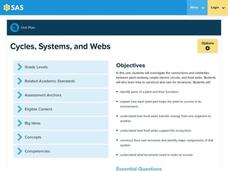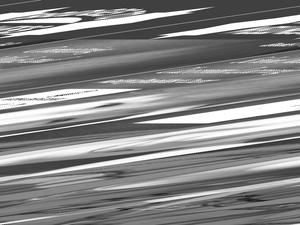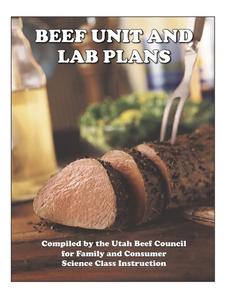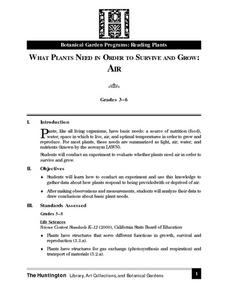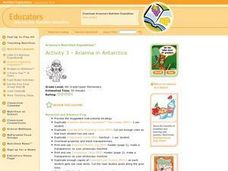Curated OER
What’s the Shape of Your Diet?
Students analyze their diets. For this healthy diet activity, students keep food journals and examine their diets next to the recommended daily allowances of MyPyramid for Kids.
Curated OER
Understanding My Pyramid
Learners examine the food pyramid and construct a healthy meal. In this food pyramid lesson, students examine the new food pyramid that includes fats and oils, and is arranged with brightly colored triangles. They use grocery store adds...
Curated OER
Jr. Chef Club
Students examine the food pyramid. In this health/math lesson students make biscuits. Students are assigned a group to measure out ingredients. Students also discuss which part of the food pyramid biscuits fall into and the nutritional...
Curated OER
Marine & Aquatic Habitats Activities - Terrestrial Forests vs. Kelp Forests
Middle schoolers discuss concept and specificity of habitats, both marine and terrestrial, list similarities and differences in the habitats of a kelp forest and a terrestrial forest, compare types of organisms that occupy corresponding...
Curated OER
Does Your Diet Stack Up?
Students investigate the food pyramid. In this nutrition lesson, students review the food pyramid and construct a list of what they eat. Students review the nutritional value of their food list and brainstorm ways to improve their diet.
Curated OER
PICTURE PERFECT PYRAMID
Learners create a model of the USDA's Food Pyramid Guide, using shoe boxes. They bring an assortment of shoe boxes from home. Students are given a copy of the "Food Guide Pyramid." They wrap boxes for the bread group in white, the...
Curated OER
Web of Life Game: Trout
Students explore the concept of food webs. In this food web lesson, students demonstarte the connection between species. Students use a ball of string show how the food web works, then have a class discussion.
Pennsylvania Department of Education
Cycles, Systems, and Webs
Fourth graders review the parts of the plant and their functions. In this plant lesson, 4th graders recognize that plants must transfer energy to make food. Students understand the interdependence of organisms in an...
Curated OER
Microorganisms: Good Guys or Bad Guys?
Learners discover the role microorganisms play in our lives. In this decomposition activity, students examine decaying foods and plants in order to analyze the different bacteria that grows. Learners discuss the good and bad of...
Curated OER
Connecting School Meals and Classroom Learning Making Breakfast Count
Students investigate the significance of a healthy breakfast. In this nutrition activity, students participate in an activity that enables them to assess their own eating patterns. Students also analyze breakfast menus to determine...
Curated OER
Ocean World
In this components of the ocean worksheet, students answer 20 questions about various species in the ocean such as plankton, different types of whales, sharks, and herring. Students also answer questions about the volume of water in the...
Aquarium of the Pacific
Ecosystem Comparison
Fifth graders examine plants and animals in two ecosystems and compare them. In this ecosystem survival lesson, 5th graders compare and contrast a coral reef and kelp forest ecosystem. Students investigate the abiotic and biotic...
Utah Beef Council
Beef Unit and Lab Plan
What are the proper methods for cooking various cuts of beef? What are some basic rules regarding meat food safety? Here you'll find 10 lab plans with a variety of beef cookery activities, perfect for a home economics or cooking course.
Cornell University
Bacteria Take Over and Down
Bacteria outnumber all other forms of life on Earth. Scholars observe the growth of bacteria in petri dishes to understand their role in maintaining good health. Then, they observe the growth of bacteria after they introduce...
Curated OER
Making Healthy Food Choices
In this well-designed nutritional activity, young scholars are given the opportunity to create their own daily food record, compare their nutrient with minimimun requirements, and think critically about their own food choices. Materials...
Curated OER
Nutrient Analysis Lab
In this nutrient analysis lab activity, students perform several experiments in a lab setting. Students test products for carbohydrates (monosaccharides and polysaccharides), proteins, lipids, and starches.
Curated OER
Forest Food Webs
Students consider the interdependency of life in a temperate forest by studying selected organisms from an Asian temperate forest and creating a food web.
Alabama Learning Exchange
Plants, Soil and Nutrients
Young scholars conduct an experiment. They review how to use the scientific method to conduct an experiment with white carnations and food coloring. They create a hypothesis and test it to better understand how plants get nutrients,...
Curated OER
Transportation in Plants
High schoolers investigate how plants transport water and nutrients through the plant. In this transportation in plants lesson plan, students use glass tubing, celery stalks, food coloring and leaves from plants to observe adhesion and...
Curated OER
What Lives in the Open Ocean and Where Do They Live?
Young scholars explore oceanography by participating in a flash card activity. In this ocean inhabitant lesson, students define a list of ocean related vocabulary terms and answer ocean geography study questions. Young scholars utilize...
Curated OER
What Plants Need in Order to Survive and Grow: Air
Students conduct an experiment to determine whether plants need air in order to survive and grow. They discuss natural resources, analyze slides, and observe and record data from the experiment.
Curated OER
Steps to a Healthier You
Students explore the food pyramid. In this dietary health instructional activity, students examine the food pyramid on the MyPyramid.gov website and discuss healthy eating strategies. There are various links to websites in this...
Curated OER
Nutrition: Why do we need rice in our diet?
Second graders discover what the Food Guide Pyramid represents. In this health lesson, 2nd graders experience the types of foods represented in each of the groups found in the pyramid. As part of this lesson, students discover one food...
Curated OER
Arianna in Antarctica
Fourth graders review their knowledge of the food groups and their benefits. They make comparison flash cards with different foods and their benefits, sharing them in creative ways. Finally, they work in groups to solved case studies...







